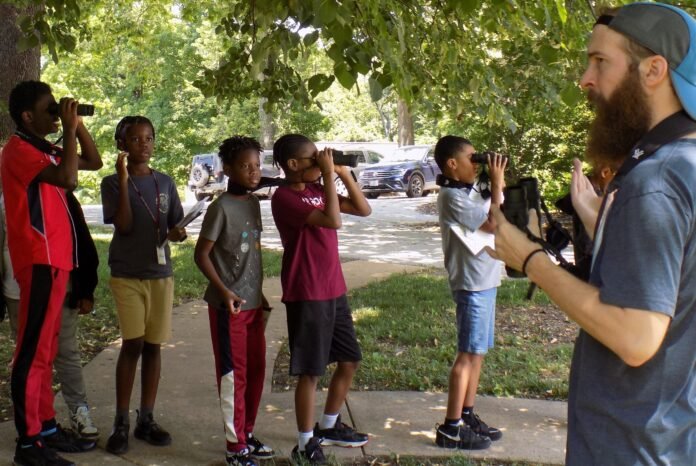School’s out for summer, but learning hasn’t stopped at Little Creek Nature Area, a program supported by the St. Louis American Foundation. The 97-acre outdoor classroom located in North St. Louis County is drawing elementary and middle school students from across the region for a hands-on STEM exploration.
Hiking trails, restored prairies, a pond ecosystem, and a Nature Explore classroom offer young learners a chance to connect with science in the wild.
“Black workers made up just 9% of the U.S. STEM workforce in 2021—a figure that has remained virtually unchanged since 2016. This lags behind their 11% share of the overall workforce, highlighting a persistent gap in representation”
Savannah Channel, 17, a mentor and student at MICDS, leads lessons on plant and animal survival. One activity had students design butterflies with camouflage patterns to blend into the classroom environment before challenging each other to spot the hidden butterflies, mimicking how creatures survive in the wild. “The kids come here to learn more about science to have a better idea of what they are learning in school,” Channel said.
Elias Scott, a sophomore at Alabama A&M University, said early exposure to programs like this is critical, particularly for Black and Brown students. “They need to see that these careers are attainable,” he said. “Opportunities like this show them what’s possible.”
The science lessons also apply to life lessons that the younger kids can use over time, Scott said.
The free, 3-week program helps underserved students create a pathway that helps them build essential life skills, strengthen their environmental awareness, and combat summer learning loss through hands-on STEM projects and literacy-focused activities. Games and group activities such as archery, birding with binoculars, campfire cooking, fishing, canoeing, and animal studies help campers build social skills while gaining outdoor experiences. The kids participate in mapping, nature journaling, and plant identification studies, which build literacy skills.
Cathy Sewell, Newspaper in Education Manager for the St. Louis American Newspaper and Director of the Summer Science Academy, says the STEM program is a great way for kids to get more one-on-one time with instructors as well as opportunities to dive into more complex science activities.
“We have five school districts participating this year,” Sewell said. “Riverview Gardens, SLPS, and Hazelwood, to name a few, all have students in the program.”
The camp welcomes students as young as third grade, offering learning activities that spark curiosity and confidence. While the core program runs through seventh grade, middle schoolers can graduate into leadership roles, returning as peer mentors to guide the younger participants. High school students, meanwhile, have the opportunity to engage through a partnership with Youth Exploring Science (Y.E.S.).
This summer, campers had a unique chance to learn directly from civil engineers with the Conference of Minority Transportation Officials (COMTO). Each student received a LEGO set and was encouraged to design and build their own streetscape in order to learn more about urban planning and transportation systems.
Over the past eight years, the camp has served nearly 200 students, many of whom are experiencing these kinds of opportunities for the first time.
“It’s just a lot of things some of these kids don’t get to do,” said Sewell. “When we take field trips to Illinois, it’s the first time some of them have ever left Missouri. Sewell says some of the students will make their own science projects at home just for fun.
According to Pew Research Center data, Black workers made up 9% of the U.S. STEM workforce in 2021 — a figure that has remained virtually unchanged since 2016. This lags behind their 11% share of the overall workforce, highlighting a persistent gap in representation. The disparity is even more pronounced in fields like engineering and architecture, where Black professionals account for only 5% of workers. In contrast, health-related STEM occupations are the only sector where Black representation matches the broader labor force, at around 11%.
Meanwhile, white workers comprise 67% of all STEM roles and approximately 71% of engineering jobs. The racial pay gap within STEM remains significant. In 2021, Black full-time STEM workers aged 25 and older earned a median salary of $61,100, compared to $78,000 for their white counterparts.
The National Science Board underscores the urgency of addressing these disparities, stressing that a diverse STEM workforce is vital to U.S. innovation, competitiveness, and long-term leadership in science and technology.
Doug Schilling, program manager for Y.E.S., said having mentors who look like the majority of the kids being served is helping bridge that gap and developing a pathway to help them succeed. “Y.E.S. serves the underserved African-American community, and this is a great time for the campers to see role models that can lead and show a good example of what they can do,” he said.






